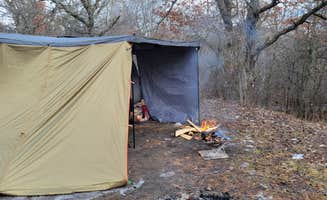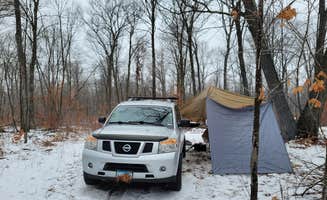Dispersed camping near Holdingford, Minnesota presents primitive backcountry opportunities between flat terrain and sandy soil conditions. Winter temperatures in the region frequently drop below zero, while summer brings humid conditions and temperatures in the 80s. Most dispersed sites remain accessible from May through October, with several forest roads closing during spring thaw periods when surfaces become unstable.
What to do
Wildlife observation: At South of Sand Dunes State Forest, visitors can spot sand hill cranes and various bird species. "This is a nice quiet area. Some younger people coming through sporadically playing with their trucks but nothing serious and not often," notes Jason B. Be cautious around nesting birds as "Sand storks are very protective. Stay away from them. They attack," warns Heather W.
Hammock camping: Multiple sites accommodate hammock setups between stands of pine and oak. "I was able to walk in and find an incredible spot to camp and lay in my hammock," reports Joslyn H. about Sand Dunes State Forest. This setup works well during bug season as it elevates campers above ground-level insects.
Hiking forest roads: Limited maintained trails exist, but forest roads provide walking routes with minimal traffic. Campers frequently walk along road systems when ticks become problematic in deeper forest areas. According to one visitor at Rum River State Forest Dispersed, "After finding a tick quickly we just hiked along the road. Only one other camper so during the non-hunting season this might be a good stopover."
What campers like
Proximity to Twin Cities: These dispersed sites offer accessibility while still providing solitude. "I love that it's so close to home," mentions Joslyn H. about South of Sand Dunes. Another camper notes, "If you want secluded, minimal camping. This is an okay spot, close to the twin cities."
Variable cell service: Some campers appreciate disconnecting while others find sufficient coverage for remote work. "The cell service with Verizon is good enough to stream videos and work on your laptop with ease," reports Erin G. at Rum River State Forest, while South of Sand Dunes generally has "Weak cell service but manageable."
Spacious parking areas: Many sites accommodate larger vehicles despite rustic conditions. "Most of these spots are cutoffs on the sides of the dirt road. They are deep and have plenty of room," notes Skip H. Another Rum River camper confirms, "Pull off sites big have a 37 ft fifth wheel no problem nice an quiet."
What you should know
Vehicle traffic considerations: Forest roads experience varying traffic levels depending on location and time of week. "This road is pretty busy for a dirt forest road and people FLY down it. Almost got hit a few times walking. Even through a Wednesday night cars are flying down the road," warns Ryan P. about South of Sand Dunes State Forest.
Wildlife encounters: Beyond insects, larger wildlife inhabits these forests. "I did hear wolves for the first time. They were howling after sunset. A little creepy, camping alone. But, I don't suspect they'd come too close," recounts Johnny H. from Rum River. Multiple campers report seeing deer throughout both forest systems.
Law enforcement presence: Ranger and sheriff patrols monitor these areas regularly. One camper reported: "I had a county sheriff person tell me it's not lawful to park a trailer and they kicked me out. I called the DNR and they said that wasn't right but I decided to leave anyway."
Tips for camping with families
Insect protection essentials: Prepare for significant insect pressure, particularly during summer months. "Alot of ticks but had a great time," notes Ronney P. about Rum River. Multiple campers mention heavy mosquito activity after rainfall, requiring full coverage clothing and repellent for children.
Site selection strategy: Choose sites away from road intersections where traffic increases. "Campsites were pretty far apart. Not bad, quiet, aside from the occasional truck speeding through," notes a South of Sand Dunes visitor. The most family-friendly sites typically appear 1-2 miles from main entrance points.
Water planning: Neither forest provides potable water sources. One Rum River State Forest camper advises: "No potable water, grey dump, nor trash cans, but it's rugged wilderness along a gravel road with plenty of space to park." Plan to bring 1 gallon of water per person per day plus additional for cooking and cleaning.
Tips from RVers
Site access assessment: Drive through before committing to a specific site with larger vehicles. "Best for straight vehicles or very small trailers," advises Skip H. Some sites have low-hanging branches that can damage taller rigs: "We did find one we thought we liked, but branches over hung, and rested on our camper (8ft high)."
Road condition awareness: Surface quality varies significantly by season. "The roads aren't really kept up for the winter. So, you'll want 4 wheel drive and slow and mindful driving," notes a Rum River camper. Spring conditions often create muddy sections that can trap two-wheel drive vehicles.
Ideal camping timeframes: Weekdays provide significantly less traffic and more site options. "Came back on a warm weekend. A bit more traffic, but after 12 p.m., not much of anything. I really recommend this for an easy stop if you're looking for a place to put up," suggests Skip H. about a midweek stay at South of Sand Dunes.



